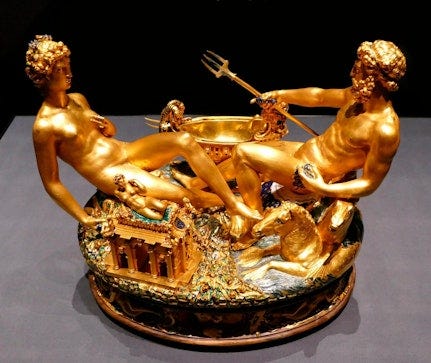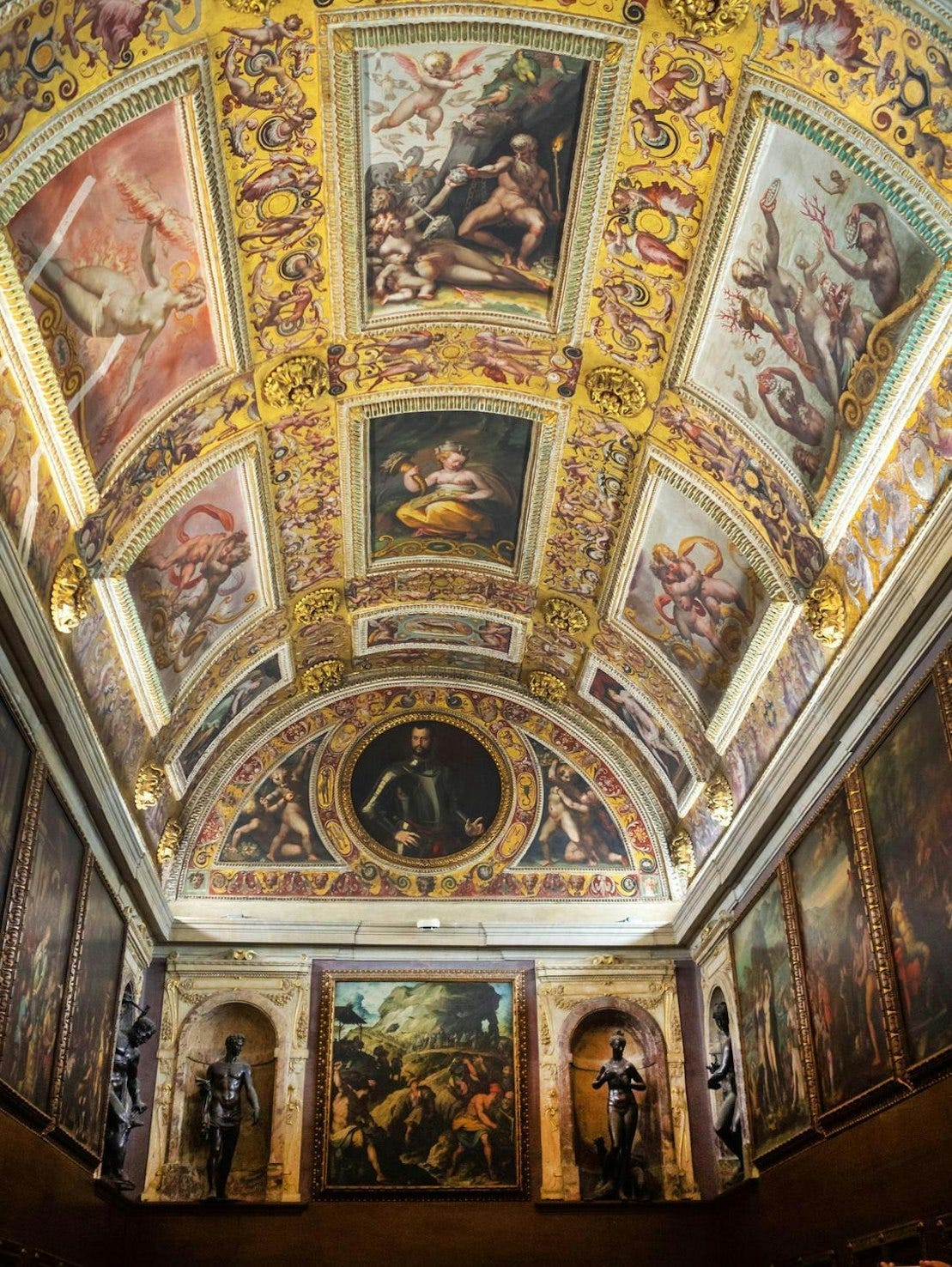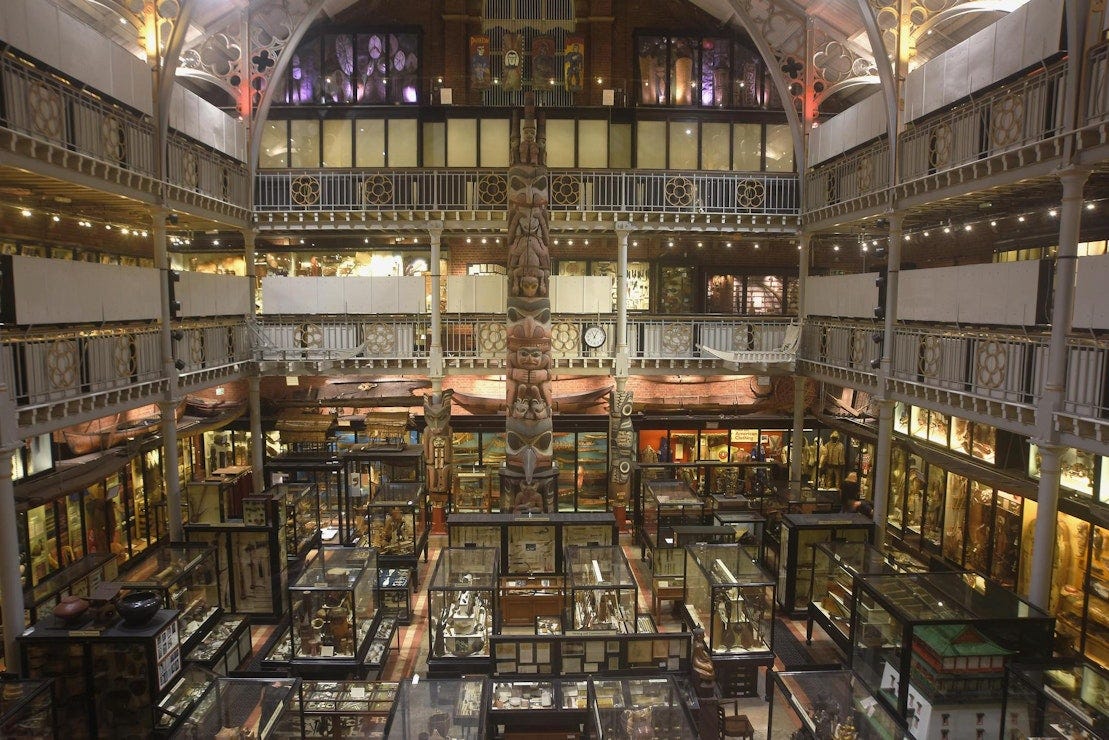
Curiously, Britain has few equivalents to the European Kunstkammer or “chamber of art” even although the concept is generally acknowledged as the foundation of the great encyclopaedic museums of the world.
Wandering around the great galleries of these institutions, we can move, thrillingly, from Ancient Egypt, to sub-Saharan Africa to pre-Qing dynasty China through Ancient Greece and Rome and on and on across space and time. This geopolitical and historical arrangement is neat and orderly: it satisfies the way we have been taught to look at the world and history, which is to say as a series of civilisations which supplanted one another as cultures tumbled through the battlefields and the trading entrepôts of history.
Although some of the great didactic museum collections were assembled in the nineteenth and twentieth centuries, especially in America, their roots were established in the preceding century. The British Museum was founded in 1753, with the natural history collection of Sir Hans Sloane as its nucleus. Sloane (and others, like Dr Richard Mead) assembled naturalia and other works of art in the manner of a seventeenth-century collector-Prince.

Princes at courts of Munich, Vienna, Prague, Dresden, Berlin, Copenhagen, Stockholm, Florence and Milan formed extraordinary collections of rare objects, which were usually displayed according to type in dedicated series of rooms, often with free-standing tables and cabinets lining the room.
Other well-known individuals formed highly personal and famed collections around the turn of the seventeenth century, such as Conrad Gessner in Zürich, Ulisse Aldrovandi in Bologna or Andreas Vesalius in Antwerp. Very few of these collections or “cabinets” survive intact today; most suffered the depredations of time, conflict and changes in fashion. Fighting in the Thirty Years War was responsible for the destruction and also the relocation of at least one of these collections (to Stockholm).
These early collections were assembled and shown with rather different principles to those of the modern museum. The modern idea of the museum is not especially old: in the Middle Ages great collections of objects were held by the Church, in cathedral and abbey treasuries. The princes of the Middle Ages certainly owned beautiful objects, but these were intended to dazzle and were not gathered or retained for the benefit of future generations — on the death of a prince the collections were dispersed and new pieces acquired for the heir.
This attitude seems to have changed in the Renaissance, when scholars and princes began to consider the place of humanity in the world. It was especially in the German and Italian-speaking lands that some sort of codification of what constituted a collection — indeed a museaeum — was set down. A handful of treatises have survived from that time which set out how to form a collection.
The earliest was written by the librarian of Albrecht V, Duke of Bavaria, who formed an immense collection of art in his Munich palace, the Residenz. The treatise, Inscriptiones vel tituli theatri amplissimi, 1565, by Samuel Quiccheberg, is a manual for forming the ideal museum, although there is no evidence the duke heeded it. Quiccheberg provides 53 headings or “inscriptions”, each of which are subdivided into various categories of object, including sacred history, applied arts, technology and genealogy.
Another treatise, written in 1587 by Gabriel Kaltemarckt and sent to the Danish prince Christian I, was also intended as a guide to forming a collection, although, like the Inscriptiones there is no proof that Christian took any notice: despite this indifference to conceptual rigour, the Danish royal collection today at Rosenborg Castle in Copenhagen contains one of the great European renaissance collections.
On the whole, objects in a Kunstkammer were divided amongst three categories: artificialia (works of human ingenuity), naturalia (works of natural wonder) and scientifica (works associated with scientific enquiry and discovery). Even in 1700, when the fashion for such collections had passed, a Jesuit visitor to the princely collection in Graz, declared it was a “gallery in which you believe the world is enclosed, since it contains the curiosities of many peoples”.
The intended aim of these museums, art chambers or Kunstkammern was new: to attain knowledge of individual things and to gain some sort of insight into the world or human ingenuity. For princes, the magnificence and importance of the collection was also a consideration: to magnify the importance of the prince-collector, whose thoughtfully-assembled collection of rarities revealed the wisdom and worldliness of the ruler.

By 1560 the electors of Saxony had started gathering the objects which evolved into one of the greatest Kunstkammern of Europe, today known as the Green Vault. The most important art historical Kunstkammer collection of all was formed by the Habsburgs in Vienna. Gathered in the city’s Kunsthistorisches Museum, it includes the saliera (salt cellar) made by Benvenuto Cellini in 1540-43, given by Charles IX to Archduke Ferdinand II in 1570.
In Florence, the Medici formed an extraordinary collection of rarities, now part of the Museo degli Argenti within the walls of the Palazzo Pitti. Likewise, most other Italian princes had their own smaller collections, kept in their private library or studiolo.
Most of these collections, however, have now been merged into modern museums. Indeed, the two oldest collections in the UK, the British Museum and the Ashmolean Museum, were created from these scholarly Kunstkammern. The Ashmolean is based on the collections of Elias Ashmole and John Tradescant, and the British Museum’s core collection is that of Hans Sloane, celebrated in the Enlightenment Gallery there.
There are now few European castles where it is still possible to experience how these collections were originally shown. At Schloss Ambras, Innsbruck, Archduke Ferdinand II of Austria’s Kunstkammer has been redisplayed based on the inventory of 1596 (see image above). The other great surviving Kunstkammer collection is that of the Esterhàzy family at Burg Forchtenstein, also in Austria, where the display is based on an inventory of 1692. It is the most complete collection shown in its original, spectacular setting.

In the United States several institutions have created their own, present-day recreations of a Renaissance-era Kunstkammer. One of the finest is at the Wadsworth Atheneum in Hartford, Connecticut, and there are similar displays at The Walters Art Museum in Baltimore and smaller groups in The Museum of Fine Arts, Houston. Meanwhile the Museum of Fine Arts in Boston has a special gallery with objects made from exotic materials. Perhaps the general revival of interest in the Kunstkammer derives from the problem of the geopolitical approach to presenting civilisations and their objects, along the lines displayed by the British Museum. In the museum world, this sort of arrangement is beginning to look a little like a descendant of colonial-era expansionism.
In Paris in the 1920s and 30s, a three-way dialogue about how to show the works of other cultures was brought about by, first, the academic Marcel Mauss, director of the Institute of Ethnography, who advocated a scientific method of observing cultures in the field and then, second, by Paul Rivet, the director of the Trocadéro Museum of Ethnology. Rivet believed in the physical anthropological and evolutionary approach. Third, his museum deputy, Georges Henri Rivière, who was brought in to satisfy the tastes of rich collectors, promoted an aesthetic arrangement where great objects were shown in a “Hall of Treasures”.
These three different approaches were combined in the establishment in 1998 of a new museum in Paris, the Musée du quai Branly-Jacques Chirac, where works from Africa and other world cultures are displayed as art. The Smithsonian Institution in Washington DC was similarly influenced at its genesis in 1846 by these differing museological approaches. The British Museum and most German museums favour a geographical arrangement; natural history museums tend to arrange their collections around function or type. A private collection founded on similar lines was begun in the 1850s by Prince Albert as an educational tool for his children, which later became the Swiss Cottage Museum at Osborne House.
And it is in the huge Victorian building containing Oxford University’s Museum of Natural History and the Pitt Rivers Museum that the legacy of the Kunstkammer can perhaps be best understood. In the Pitt Rivers, the collection is in crowded cases, arranged by object type, although there are one or two exceptions, such as the important case containing bronze ritual ornaments from the Kingdom of Benin, now part of Nigeria. This arrangement shows how cultures used objects to survive: to cook, eat, dress, hunt, marry, die.
Pitt Rivers and his fellow anthropologists sought to understand cultures by using the comparative approach. Some used this method to try to demonstrate offensive racial variations, but ultimately they succeeded in bringing objects together to show the variety and richness of human ingenuity.
This article first appeared in February 2025 issue of The Critic available here







Fascinating. The Enlightenment Gallery is my favourite of the British Museum, as it happens.